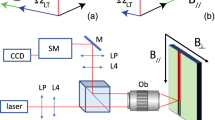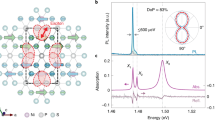Abstract
Exciton–polaritons—light–matter quasiparticles with spin degrees of freedom and ultrafast dynamics—are a promising platform for spin-based applications. However, an ongoing challenge is the generation and manipulation of high-purity polariton spins over macroscopic distances at room temperature. Here, by creating synthetic spin–orbit coupling in perovskite microcavities with liquid crystal molecules, we demonstrate the polariton spin Hall effect in the Rashba–Dresselhaus regime at room temperature, where spin-polarized polaritons with a high chirality of 0.88 are permanently separated as they propagate over 45 μm. We further show that their spin transport behaviours can be effectively manipulated by external electrical voltages. Our work represents an important step to generate purer polariton spin currents, paving the way to spin-optoelectronic applications with polaritons, such as spin lasers, spin filters and spin logic gates.
This is a preview of subscription content, access via your institution
Access options
Access Nature and 54 other Nature Portfolio journals
Get Nature+, our best-value online-access subscription
$29.99 / 30 days
cancel any time
Subscribe to this journal
Receive 12 print issues and online access
$209.00 per year
only $17.42 per issue
Buy this article
- Purchase on Springer Link
- Instant access to full article PDF
Prices may be subject to local taxes which are calculated during checkout




Similar content being viewed by others
Data availability
The data that support the plots within this paper are available via Zenodo at https://doi.org/10.5281/zenodo.10207258. All other data used in this study are available from the corresponding authors upon reasonable request.
Code availability
The codes are available from the corresponding authors upon reasonable request.
References
Dyakonov, M. I. & Perel, V. I. Current-induced spin orientation of electrons in semiconductors. Phys. Lett. A 35, 459–460 (1971).
Hirsch, J. E. Spin Hall effect. Phys. Rev. Lett. 83, 1834–1837 (1999).
Kato, Y. K., Myers, R. C., Gossard, A. C. & Awschalom, D. D. Observation of the spin Hall effect in semiconductors. Science 306, 1910–1913 (2004).
Sih, V. et al. Spatial imaging of the spin Hall effect and current-induced polarization in two-dimensional electron gases. Nat. Phys. 1, 31–35 (2005).
Kavokin, A. V., Malpuech, G. & Glazov, M. Optical spin Hall effect. Phys. Rev. Lett. 95, 136601 (2005).
Leyder, C. et al. Observation of the optical spin Hall effect. Nat. Phys. 3, 628–631 (2007).
Hosten, O. & Kwiat, P. Observation of the spin Hall effect of light via weak measurements. Science 319, 787–790 (2008).
Kavokin, K. V., Shelykh, I. A., Kavokin, A. V., Malpuech, G. & Bigenwald, P. Quantum theory of spin dynamics of exciton-polaritons in microcavities. Phys. Rev. Lett. 92, 017401 (2004).
Kavokin, A. V., Baumberg, J. J., Malpuech, G. & Laussy, F. P. Microcavities (Oxford Univ. Press, 2017).
Amo, A. et al. Exciton–polariton spin switches. Nat. Photon. 4, 361–366 (2010).
Ballarini, D. et al. All-optical polariton transistor. Nat. Commun. 4, 1778 (2013).
Sanvitto, D. & Kena-Cohen, S. The road towards polaritonic devices. Nat. Mater. 15, 1061–1073 (2016).
Dreismann, A. et al. A sub-femtojoule electrical spin-switch based on optically trapped polariton condensates. Nat. Mater. 15, 1074–1078 (2016).
Dufferwiel, S. et al. Spin textures of exciton-polaritons in a tunable microcavity with large TE-TM splitting. Phys. Rev. Lett. 115, 246401 (2015).
Sedov, E. S., Rubo, Y. G. & Kavokin, A. V. Polariton polarization rectifier. Light Sci. Appl. 8, 79 (2019).
Solnyshkov, D. D., Flayac, H. & Malpuech, G. Stable magnetic monopoles in spinor polariton condensates. Phys. Rev. B 85, 073105 (2012).
Manni, F., Léger, Y., Rubo, Y. G., André, R. & Deveaud, B. Hyperbolic spin vortices and textures in exciton–polariton condensates. Nat. Commun. 4, 2590 (2013).
Bardyn, C.-E., Karzig, T., Refael, G. & Liew, T. C. H. Topological polaritons and excitons in garden-variety systems. Phys. Rev. B 91, 161413 (2015).
Nalitov, A., Solnyshkov, D. D. & Malpuech, G. Polariton Z topological insulator. Phys. Rev. Lett. 114, 116401 (2015).
Solnyshkov, D. D., Nalitov, A. V. & Malpuech, G. Kibble-Zurek mechanism in topologically nontrivial zigzag chains of polariton micropillars. Phys. Rev. Lett. 116, 046402 (2016).
Klembt, S. et al. Exciton-polariton topological insulator. Nature 562, 552–556 (2018).
Su, R., Ghosh, S., Liew, T. C. H. & Xiong, Q. Optical switching of topological phase in a perovskite polariton lattice. Sci. Adv. 7, eabf8049 (2021).
Amo, A. et al. Anisotropic optical spin Hall effect in semiconductor microcavities. Phys. Rev. B 80, 165325 (2009).
Kammann, E. et al. Nonlinear optical spin Hall effect and long-range spin transport in polariton lasers. Phys. Rev. Lett. 109, 036404 (2012).
Flayac, H., Solnyshkov, D. D., Shelykh, I. A. & Malpuech, G. Transmutation of skyrmions to half-solitons driven by the nonlinear optical spin Hall effect. Phys. Rev. Lett. 110, 016404 (2013).
Nalitov, A. V., Malpuech, G., Terças, H. & Solnyshkov, D. D. Spin-orbit coupling and the optical spin Hall effect in photonic graphene. Phys. Rev. Lett. 114, 026803 (2015).
Shi, Y. et al. Coherent optical spin Hall transport for spin-optronics at room temperature. Preprint at https://arxiv.org/abs/2304.12854 (2023).
Antón, C. et al. Optical control of spin textures in quasi-one-dimensional polariton condensates. Phys. Rev. B 91, 075305 (2015).
Bliokh, K. Y., Rodríguez-Fortuño, F. J., Nori, F. & Zayats, A. V. Spin–orbit interactions of light. Nat. Photon. 9, 796–808 (2015).
Manchon, A., Koo, H. C., Nitta, J., Frolov, S. M. & Duine, R. A. New perspectives for Rashba spin-orbit coupling. Nat. Mater. 14, 871–882 (2015).
Nichele, F. et al. Generation and detection of spin currents in semiconductor nanostructures with strong spin-orbit interaction. Phys. Rev. Lett. 114, 206601 (2015).
Lekenta, K. et al. Tunable optical spin Hall effect in a liquid crystal microcavity. Light Sci. Appl. 7, 74 (2018).
Rechcińska, K. et al. Engineering spin-orbit synthetic Hamiltonians in liquid-crystal optical cavities. Science 366, 727–730 (2019).
Su, R. et al. Room temperature long-range coherent exciton polariton condensate flow in lead halide perovskites. Sci. Adv. 4, eaau0244 (2018).
Su, R. et al. Observation of exciton polariton condensation in a perovskite lattice at room temperature. Nat. Phys. 16, 301–306 (2020).
Su, R. et al. Perovskite semiconductors for room-temperature exciton-polaritonics. Nat. Mater. 20, 1315–1324 (2021).
Peng, K. et al. Room-temperature polariton quantum fluids in halide perovskites. Nat. Commun. 13, 7388 (2022).
Tao, R. et al. Halide perovskites enable polaritonic XY spin Hamiltonian at room temperature. Nat. Mater. 21, 761–766 (2022).
Król, M. et al. Realizing optical persistent spin helix and Stern–Gerlach deflection in an anisotropic liquid crystal microcavity. Phys. Rev. Lett. 127, 190401 (2021).
Kokhanchik, P., Sigurdsson, H., Piętka, B., Szczytko, J. & Lagoudakis, P. G. Photonic Berry curvature in double liquid crystal microcavities with broken inversion symmetry. Phys. Rev. B 103, L081406 (2021).
Li, Y. et al. Manipulating polariton condensates by Rashba-Dresselhaus coupling at room temperature. Nat. Commun. 13, 3785 (2022).
Łempicka-Mirek, K. et al. Electrically tunable Berry curvature and strong light-matter coupling in liquid crystal microcavities with 2D perovskite. Sci. Adv. 8, eabq7533 (2022).
Jia, J. et al. Circularly polarized electroluminescence from a single-crystal organic microcavity light-emitting diode based on photonic spin-orbit interactions. Nat. Commun. 14, 31 (2023).
Liang, Q. et al. Circularly polarized lasing from a microcavity filled with achiral single-crystalline microribbons. Angew. Chem. Int. Ed. 62, e202213229 (2023).
Lovett, S. et al. Observation of Zitterbewegung in photonic microcavities. Light Sci. Appl. 12, 126 (2023).
Acknowledgements
R.S. and T.C.H.L. gratefully acknowledge funding support from the Singapore Ministry of Education via the AcRF Tier 3 programme ‘Geometrical Quantum Materials’ (MOE2018-T3-1-002) as well as the AcRF Tier 2 grant (MOE-T2EP50222-0008) and Tier 1 grant (RG80/23). R.S. also gratefully acknowledges funding support from the Nanyang Technological University via a Nanyang Assistant Professorship start-up grant and the Singapore National Research Foundation via a Competitive Research Program (grant no. NRF-CRP23-2019-0007). Y.G.R. and T.C.H.L. gratefully acknowledge funding support from PAPIIT-UNAM grant IN108524.
Author information
Authors and Affiliations
Contributions
R.S. conceived the idea and supervised the whole project. J.L. fabricated the devices and conducted the optical spectroscopy measurements. W.W. and F.J. prepared the samples and provided help on the measurements. Y.G.R. and T.C.H.L. performed the theoretical calculation and discussed the results. R.S. and J.L. wrote the paper with input from all the authors.
Corresponding authors
Ethics declarations
Competing interests
The authors declare no competing interests.
Peer review
Peer review information
Nature Photonics thanks Alexey Kavokin and the other, anonymous, reviewer(s) for their contribution to the peer review of this work.
Additional information
Publisher’s note Springer Nature remains neutral with regard to jurisdictional claims in published maps and institutional affiliations.
Supplementary information
Supplementary Information
Supplementary Figs. 1–8 and Sections 1–4.
Rights and permissions
Springer Nature or its licensor (e.g. a society or other partner) holds exclusive rights to this article under a publishing agreement with the author(s) or other rightsholder(s); author self-archiving of the accepted manuscript version of this article is solely governed by the terms of such publishing agreement and applicable law.
About this article
Cite this article
Liang, J., Wen, W., Jin, F. et al. Polariton spin Hall effect in a Rashba–Dresselhaus regime at room temperature. Nat. Photon. 18, 357–362 (2024). https://doi.org/10.1038/s41566-023-01375-x
Received:
Accepted:
Published:
Issue Date:
DOI: https://doi.org/10.1038/s41566-023-01375-x



